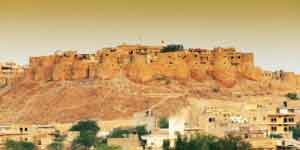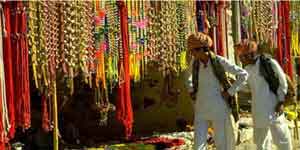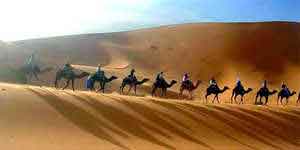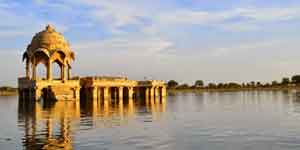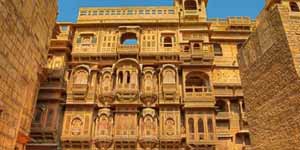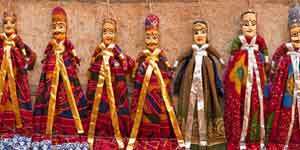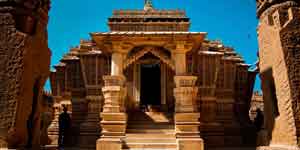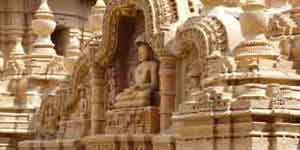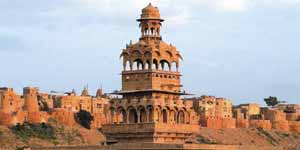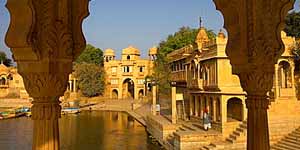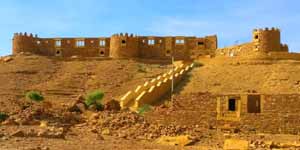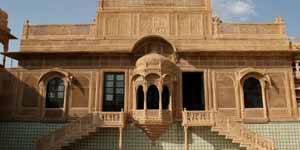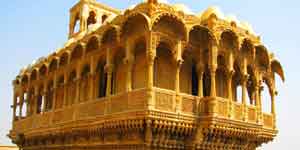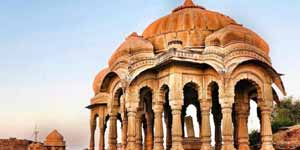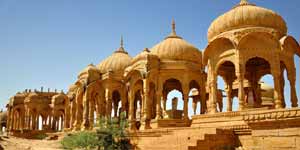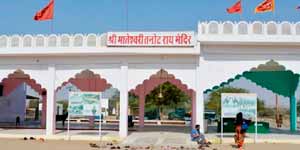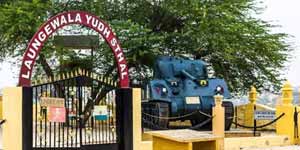

Jaisalmer of Monuments are well known for their architectural splendour. Located far out in the Thar Desert, Jaisalmer rises like a mirage from the sands, a huge fortified city in the middle of nowhere. Apart from the fort, there are a number of other monuments at Jaisalmer which evidence the might and grandeur of the Rajput warriors. The town was founded by Prince Jaisal in 1156, and functioned as the capital of the Bhatti Rajputs. It grew to be a major trade centre for camel trains, linking the routes from India to Egypt, Arabia, Persia, Africa and Europe and controlling the way into northern India across the desert.
Jaisalmer fort has narrow winding pathways which interlock several parts of the fort. The complex of Jaisalmer Fort is so expansive that almost one-quarter of the town’s population located in this fort itself.
The most famous splendid structures such as the Maharawals located in front of the Chauhata Square. The foremost attraction of this place is Maharawal’s marble throne which is placed over a flight of marble steps.
An added famous tourist attraction of this place is a five-storied Tazia tower located head-to-head to the Maharawals palace.
This tower was constructed by Muslim craftsmen and is made with decorative Bengali styled roofs.
The one more beauty section in the palace is the Jawahar Palace is among the other tourist attractions of Jaisalmer fort which was the residence of a royal family.
This place is famous for its beautiful construction and ornate design which captivate tourist’s attention during their visit to this palace. Ganesh Pol, Rang Pol, Bhoota Pol and Hava Pol are the entrance gates of this fort which is known for sculptured beauty and beautiful design.
Some Havelis are many hundreds of years old. In Jaisalmer, there are many elaborate Havelis carved from yellow sandstone. Some of these have many floors and countless rooms, with decorated windows, archways, doors, and balconies.
The most visited places of this fort are the Raj Mahal, The Jain and the Laxmikanth Temples and several other temples and gateways.
The town at the base of the citadel was enclosed by a fortified wall in 1750 by Maharawal Mulraj. There arc four important gateways to the city wall: Gadhisar Pol, leading to the Gadhisar Tank, which has a fine gateway adjacent to it; Amarsagar Pol; Baron-Ki-Pol; and Malka Pol. There are also two gateways to the south, which were later sealed.
The Havelis of Jaisalmer, or mansions of the Rajput nobles are some extremely fine monumental constructions. They are beautiful town houses built of honey-coloured sandstone and enriched with delicately carved facades. They have balconies of the finest jail work overlooking the narrow streets. Behind these intricate stone screens the women withdrew in Purdah.
Salim Singh ki Haveli was built in 1815, possibly on the core of an earlier building of the late seventeenth century. It was the residence of the influential Mohta family. It has a beautifully carved roof and exquisite details in the carvings with brackets in the form of peacocks. The entrance is guarded by a large stone elephant. The Haveli is often called the Jahazmahal because the upper portion of the house oversails boldly like a ship's prow. The top two stories -the Kanchanmahal and Rangamahal- were once adorned with glass mosaics and bright colours. The Haveli is currently still occupied.
Nathmalji-ki-Haveli was built for the prime minister of the priestly state of Jaisalmer in 1885. The entrance is flanked by stone elephants and the entire facade is carved with a riot of ornamental detail - soldiers, horses, elephants, flowers and birds. The building was designed and built by two craftsmen-architects Hathi and Lulu. One architect carved on the left side and the other on the right, but the overall impact is of complete harmony. Unlike the usual style, the house is built of rock and not dressed stone. In the main room at first-floor level the entire front wall is a huge, single rock carved into a bay. The inner walls are counter pointed with beautiful miniatures.
The largest and most elaborate of all the Havelis is the Patwon ki Haveli. It was built in 1805 as one of a group of five built for the Patua brothers. The entire front is carved with elaborate detail. It stands in a narrow alley and has beautiful murals.
Yet another haveli, the Simla Haveli is a 500 year old building in the Jaisalmer fort. The Haveli of the Prime minister of Jaisalmer is the Haveli Shreenath. It is a beautiful 450 year old Haveli which was once occupied by the Prime Minister under the Maharajah. The haveli has gorgeous archways, alcoves and spacious rooms.
The Mehra Haveli was built by the Mayor of Jaisalmer city, Gopikishen Mehra. It was named after his grandmother Parwati Devi as Parwati Sadan. On the other hand, the Jawahar Niwas lies outside the town. It is an opulent palace built as a guest-house for private visitors. On the banks of the Amar Sagar, a few miles west of Jaisalmer, is the pleasure palace of Amar Singh, built around a courtyard with an extensive formal garden.
There has been increasingly seen a resurgence of the town due to the military presence here. Jaisalmer is a popular site for tourists as it still tells the tale of the glorious Rajputs through its various monuments.
